

Thesis Defense PowerPoint: Presentation Structure and Slides Content
Last updated on July 13th, 2024
Writing a thesis is as important as defending it. The goal is not only to present one of the largest papers you ever worked on throughout the university years but also to build a strategy and create a presentation that answers all questions the audience might have.
Of course, today, this task is largely facilitated by modern technologies. PowerPoint and other programs let you create a perfect background for your defense. It helps you stay in control of the whole presentation and also includes all the important numbers and facts for the audience.

Creating a presentation for a thesis is not a piece of cake. Many students would say that they’d rather write a paper than work on a PowerPoint presentation. Since it’s academic, it also has its requirements and specifics. Of course, companies where you buy college essays can help you with pptx files as well. Yet, knowing all dos and don’ts to add your own voice to the presentation can help you ace your defense.
That’s why we decided to analyze a few structure and content tips to help you author your thesis defense presentation and make sure you get a high grade. But let’s discuss best presentation-making practices first.
What Should You Know About Presentation Making?
Before you start working on a presentation, you have to understand the level and the needs of your audience. If we talk about a thesis defense presentation , you will present your research paper to people knowledgeable in your field. There is no need to translate terminology in this case.
Remember that your presentations should be simple and easy to read. If you basically copy-paste the text from your thesis to the slides, you’ll create a wall of words. This brings zero value. Instead, you should make every slide look engaging. This can be achieved if you set to add only key facts there.
There is a golden rule for presentation making. Create no more than 10 slides, take no more than 20 min, and use a font size of no less than 30 points. If you follow it for every academic work you need a presentation for, you’ll most likely get a high grade.

How to Structure Your Presentation and What Content to Include?
Here are some slide guidelines that you can consider for thesis defense presentations if you are wondering what to put in a research defense PowerPoint presentation:
1. Title Slide
The title page starts the whole presentation. It gives the audience an idea about the thesis and the course. Make it simple but appealing to highlight your scientific goals while following best academic practices.
A regular title slide page includes the thesis title, your name, university, and course details. Sometimes, it’s recommended to mention your advisor’s name on the title page as well. A title slide for a thesis presentation typically fits in one single slide.
2. Introduction of the Presentation
There is no surprise that your presentation will repeat the structure of your thesis to a certain extent. That means you’ll have to include a proper introduction into your presentation as well.
On that slide, you’ll need to mention the topic once again to keep the audience focused. Also, you’ll be giving more details about the questions and goals of your research. Your audience has to understand the purpose of the paper that is in front of them. You have to make it clear for them what things you are investigating in particular.
3. Acknowledgements Slide
Say Thank you to your collaborators for their help in putting this presentation together. You would also like to thank the teachers and professors who have helped you during the preparation of the thesis. Here is the place to do it. The acknowledgments slide can be added at the beginning of your presentation, or at the end.
4. Literature Review Slide
This slide is not a requirement. However, if you want to render literature sources that you used for your research based on certain criteria, this is the right place to do it. You can provide your audience with a brief understanding of the resources you relied on.
First of all, you can specify the theories that you consider in your research. Secondly, you can highlight weaknesses that exist in current research. In certain cases, it can help you avoid some uncomfortable questions throughout your defense.
5. Methodology Slide
Every thesis paper is written with its own methodology. It’s better to define the tools and methods right away to add a framework to your paper.
This part helps you narrow down your thesis, actually. This is a good thing because you won’t be asked questions pertaining to methods and information not used within your research.
How many slides you need to dedicate for the Methods content? The total number of slides will depend on the case, but typically you can consider from one to three slides. Slide 1 for Study Design, Slide 2 for Measures and Slide 3 for the Sample.
6. Presentation of Results
A few slides that show results should be one of the most comprehensive parts of your presentation. We highly advise you to check this section for all relevant numbers and findings to make it informative.
The thing is that thesis papers crafted by companies where you can order cheap essay online may not include formulas or calculations for diagrams and charts. Nevertheless, you’ll have to include infographics in your presentation.
This is why you have to request these calculations and formulas from your writers or ask them to work on the presentation as well. The point is that you have to know the depth of your research before you start defending it. These details are a part of your grade.
7. Discussion
The discussion part of your thesis presentation should focus on major findings from your research with regard to the discipline program and the goals of this study. You need to explain why you believe these findings are relevant and that much significant. Also, you may provide a few ideas on how your findings relate to what others found in the past. In addition, this is the part where you explain outstanding data or unusual results.
Remember that you are not limited by the number of slides in this section. However, you should keep in mind that only the most important ideas should go into the presentation.
8. Conclusions
To finalize your presentation, you must end it with a proper conclusion. Again, the best practices of presentation making suggest that you should include only key ideas in your slide. You need to convey the rest in a verbal message. This is a bit hard to do when it comes to the conclusion.
However, the goal is to answer the questions you set at the beginning. If you can prove or debunk your thesis statement, consider you have fulfilled your research mission.
9. Future Works or Future Directions slide
In order to make the most of this thesis presentation, future work will involve a number of different people. Some of these people will be responsible for creating the slides and videos that are used in the presentation, while others will be responsible for making sure that all the materials are up-to-date and error-free.
A timeline for this future work can be included in a future work slide, but what to include on this slide will depends on a variety of factors. In this slide, you can present the audience how you envision the future work of your research, who will be doing it, what resources are required, and the different milestones. Typically, a timeline slide design can be used in this section, but you can also use a multi-step slide to describe a list of points. This can be a final slide of presentation unless you want to give space for questions and answer section (Q&A).
Building your thesis is already a tough task. Presentation is considered an add-on that has recently become a must. That is why you should take it seriously and make sure you follow the tips above to ace your defense and wow everyone with your research.
Leave a Comment Cancel reply
Your email address will not be published. Required fields are marked *
Save my name, email, and website in this browser for the next time I comment.
Sign up to our newsletter
We will send you our curated collections to your email weekly. No spam, promise!
JavaScript seems to be disabled in your browser. For the best experience on our site, be sure to turn on Javascript in your browser.
Newly Launched - AI Presentation Maker

Researched by Consultants from Top-Tier Management Companies
AI PPT Maker
Powerpoint Templates
PPT Bundles
Kpi Dashboard
Professional
Business Plans
Swot Analysis
Gantt Chart
Business Proposal
Marketing Plan
Project Management
Business Case
Business Model
Cyber Security
Business PPT
Digital Marketing
Digital Transformation
Human Resources
Product Management
Artificial Intelligence
Company Profile
Acknowledgement PPT
PPT Presentation
Reports Brochures
One Page Pitch
Interview PPT
All Categories
Must-Have Thesis Defense Templates with Examples and Samples

Stepping onto the distinguished stage of your thesis defense is akin to performing a symphony of your research after losing many hours of sleep. The more time passes, the more your hands sweat, your heart beats faster, and your thoughts start racing. But what if there was a way to choreograph this terrifying experience into something beautiful?
Recent research by HigherEd Insights found that 90% of students who utilized well-designed thesis defense templates expressed enhanced confidenc e. These best thesis presentation ppt templates, carefully designed to highlight your research process, will save you time while presenting and add visual polish to your message.
Remember, your story has to amaze, educate, and convince the audience. Here is when the power of SlideTeam's Thesis Defense Templates becomes apparent. SlideTeam's templates will turn your study into an exciting narrative . When you use striking images that virtually jump off the screen with eye-catching statistics and bullet points, your presentation will be remembered as an unforgettable adventure.
It's time to transform your thesis defense from a nerve-wracking ordeal into a show that deserves a standing ovation. Here, we'll show you the ropes on thesis defense templates you can't live without. Get started today!
Deck 1: Sample PPT For Thesis Defense Presentation Slides
Template 1: prepare agenda for thesis .
This PPT Slide will serve as a map to help you and your audience navigate the complex terrain of your thesis. This slide serves as your presentation's road map, covering key points and concepts in a way that's both concise and thorough. By laying out your arguments logically, you may both wow your reviewers and avoid getting off track. This PPT Layout is perfect for any presenter since it eliminates any potential for error and sets the tone for a convincing defense of the argument.
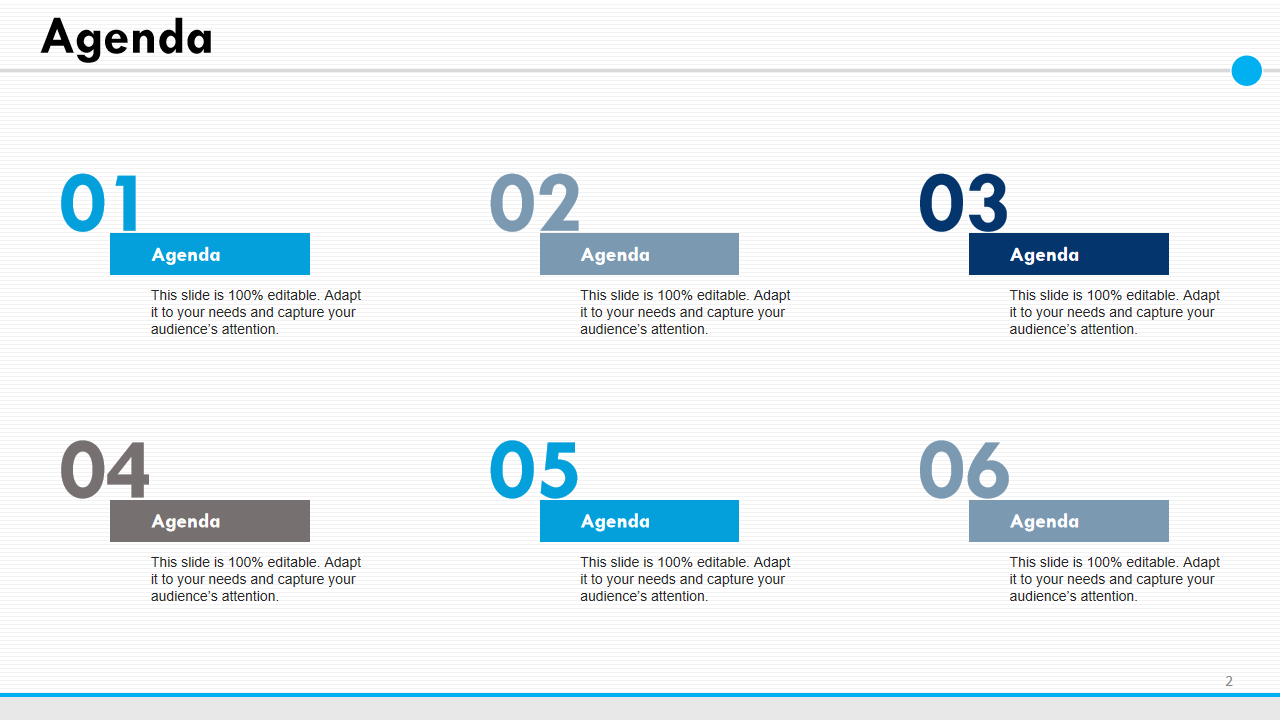
DOWNLOAD NOW
Template 2: Thesis Presentation Outline: Guiding Your Narrative with Precision
This slide maps out your journey, from the grand curtain-raiser (Title Slide) to unveiling the behind-the-scenes mechanics (Methods), spotlighting your discoveries (Results), and culminating in a crescendo of insights (Conclusions). By offering a straightforward study design encompassing introduction, purpose, statistical analysis, discussions, and reference slides, this versatile slide empowers presenters of all disciplines to lead their audience through an immersive, well-structured thesis narrative.
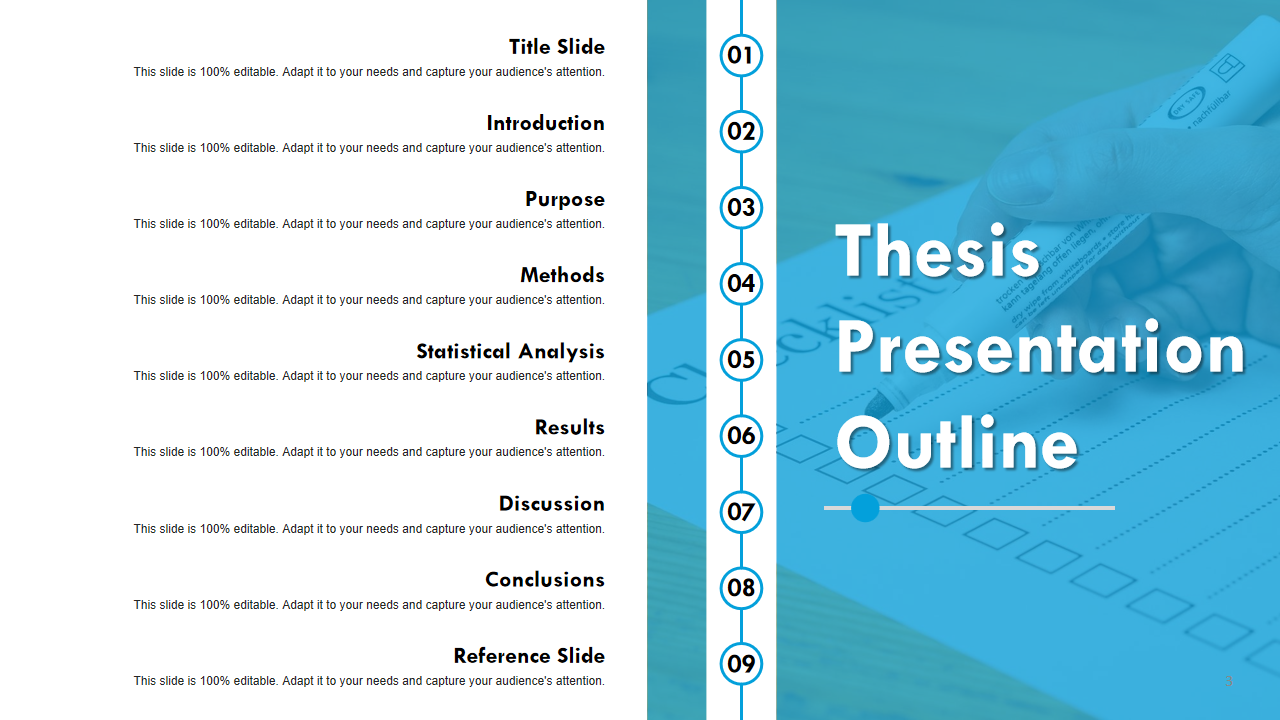
Template 3: Title Slide to Fascinate First Impressions
This PPT Template includes your name, the qualifications of your thesis adviser, and your academic accomplishments, and it sums up the substance of your work. This slide is more than a formality; it's an introduction to your study that will captivate your audience. This slide may be used by presenters in any discipline to immediately establish authority, make an indelible impression, and communicate the value of their research. Put your best foot forward academically, and in life, by letting your title slide do the talking.
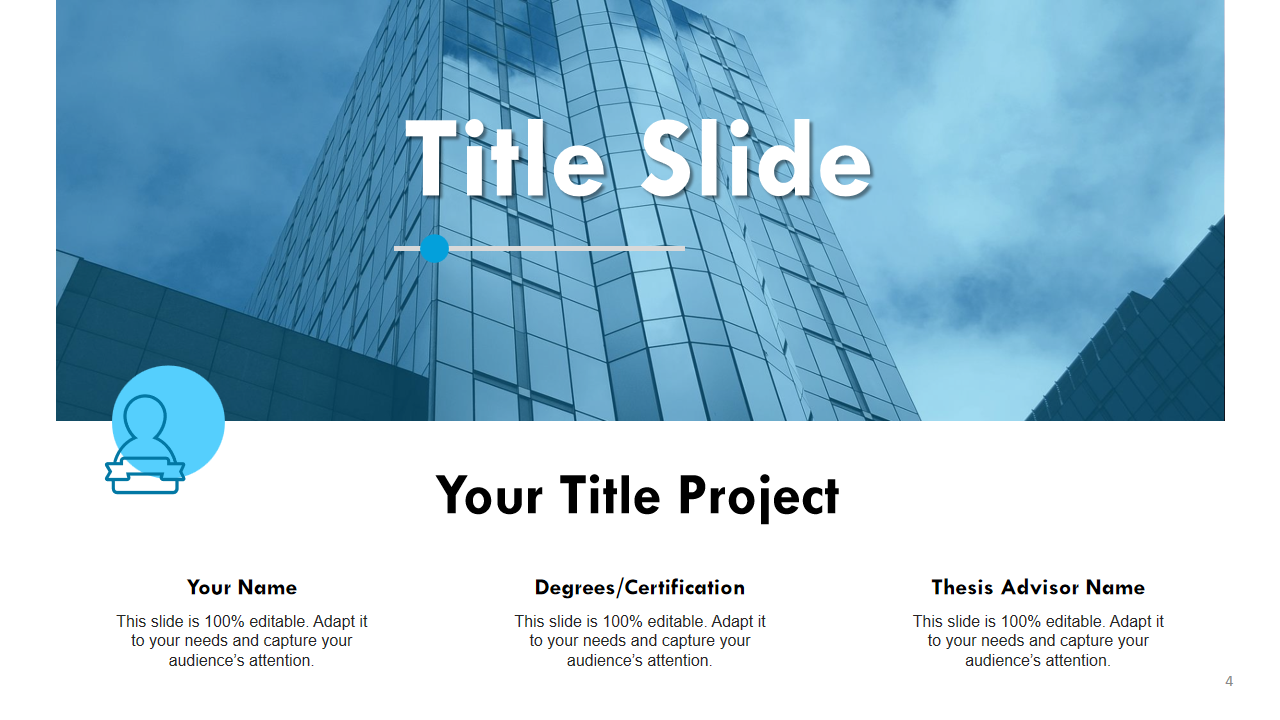
Template 4: Data-Driven Insights from a Statistical Analysis of the Thesis
This slide displays the results of careful data analysis, procedure processing which shine a light on the significant questions of your research. This PowerPoint Presentation can help anybody understand complicated results, whether scientists, economists, or social scientists. It's a visual representation of your analytical skills that will impress both data enthusiasts and quality assurance specialists.
Check out our blog on top thesis timeline templates to make your thesis more effective.
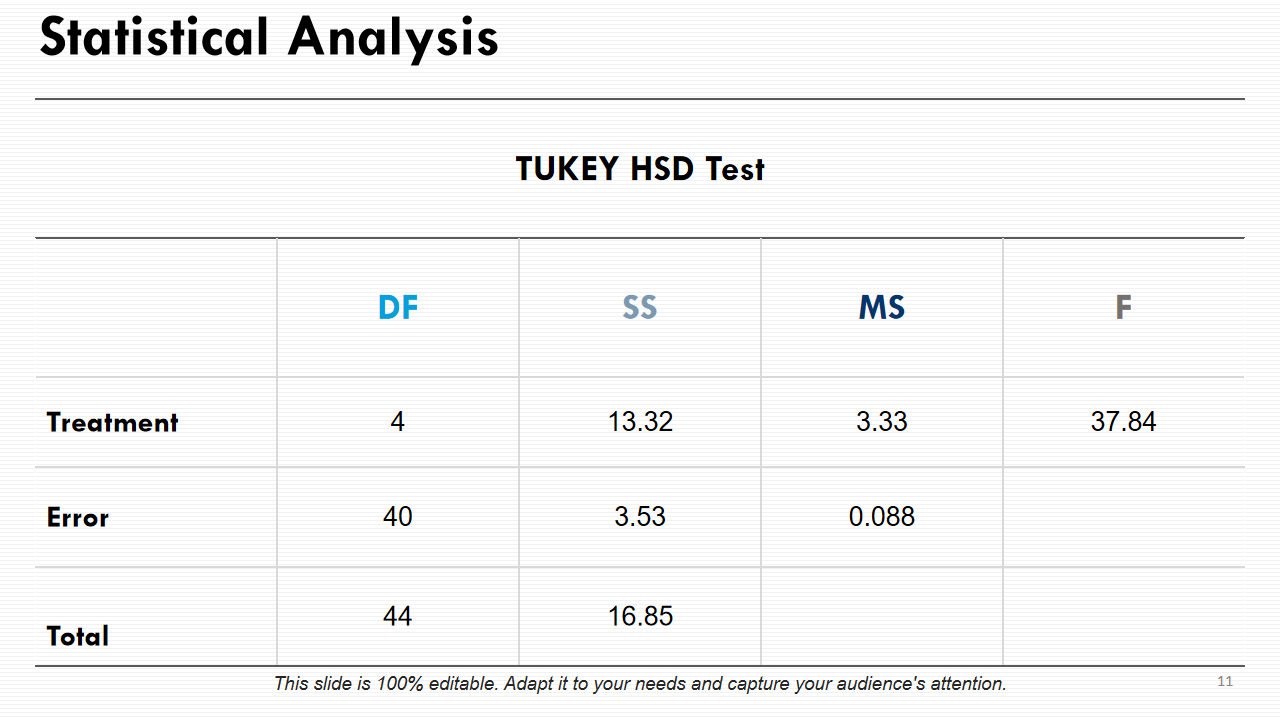
Template 5: Constraints on Your Research: Find Limitations
The limitations of your study are discussed here, whether they are related to the research's technique, data collecting, or overall scope. This presentation has a dual purpose: to show you understand where you might improve and start conversations about how to do so. This slide is helpful for all speakers, from novice academics to seasoned researchers, since it encourages honesty and demonstrates the speaker's ability to handle the complexity of their topic with modesty and understanding.
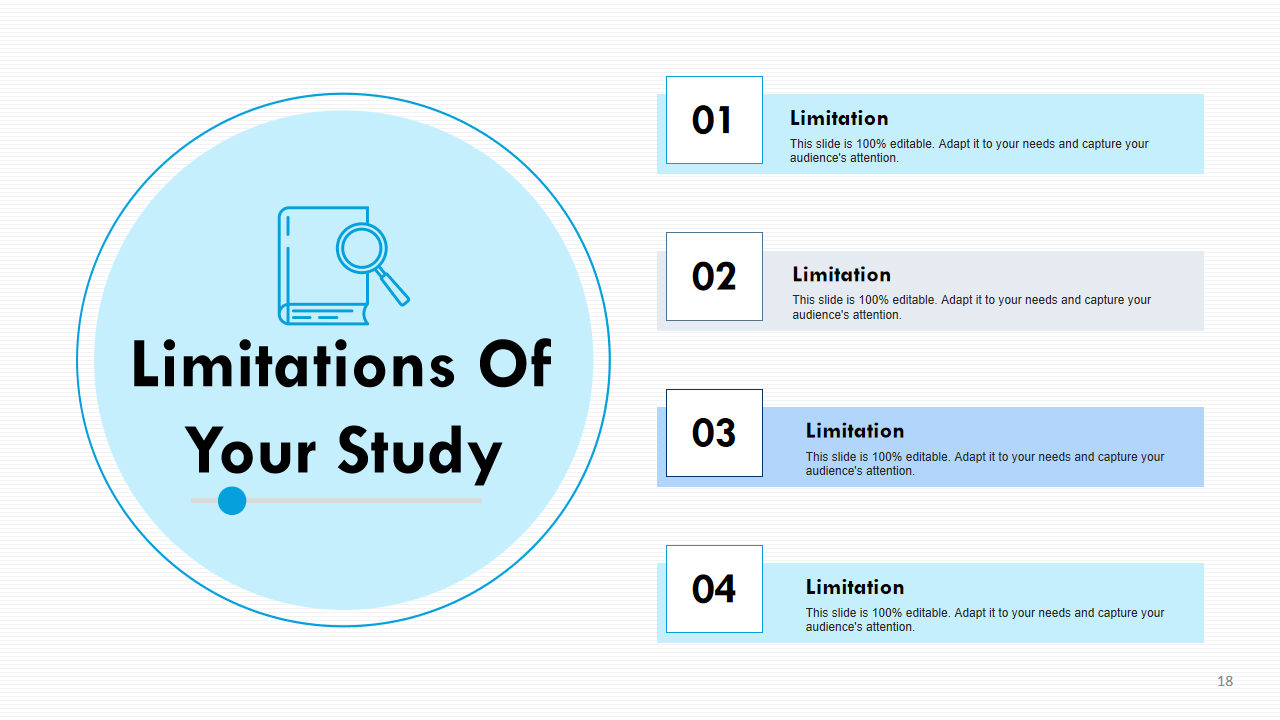
Deck 2: Thesis Defense Roadmap Individual Researcher Strategy Presentation
Template 6: do's and don’ts to defend content on thesis.
Examine the priceless "Dos and Don'ts to Defend Content" slide, your one-stop-shop for prevailing in the thesis defense. Here you'll learn tactical strategies (Do) to articulate your ideas with assurance, interact with reviewers, and provide considered responses to questions. This slide is a guidepost for students and academics alike; it will help you get through the tough examination of a thesis defense and flourish by giving you the tools you need to make your topic sparkle and persuade your audience at every turn.
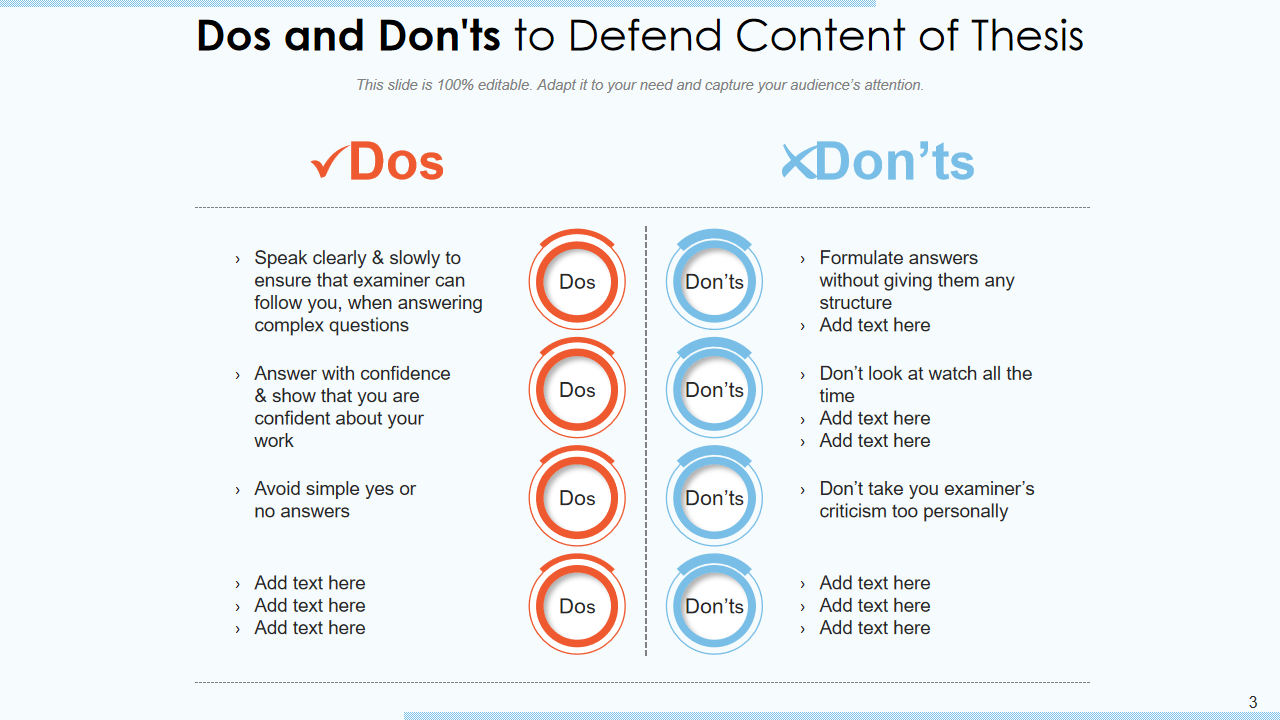
Template 7: Five-Year Roadmap for preparing thesis defense report
Use the "Five Year Roadmap" slide as a roadmap to efficiently organize your efforts leading up to the defense of your thesis. This well-crafted schedule covers everything from choosing a subject and completing literature reviews to honing your methods, analyzing your data, and writing up your findings. This slide serves as a map for students on academic adventures, outlining a path they may take to defend their theses successfully.
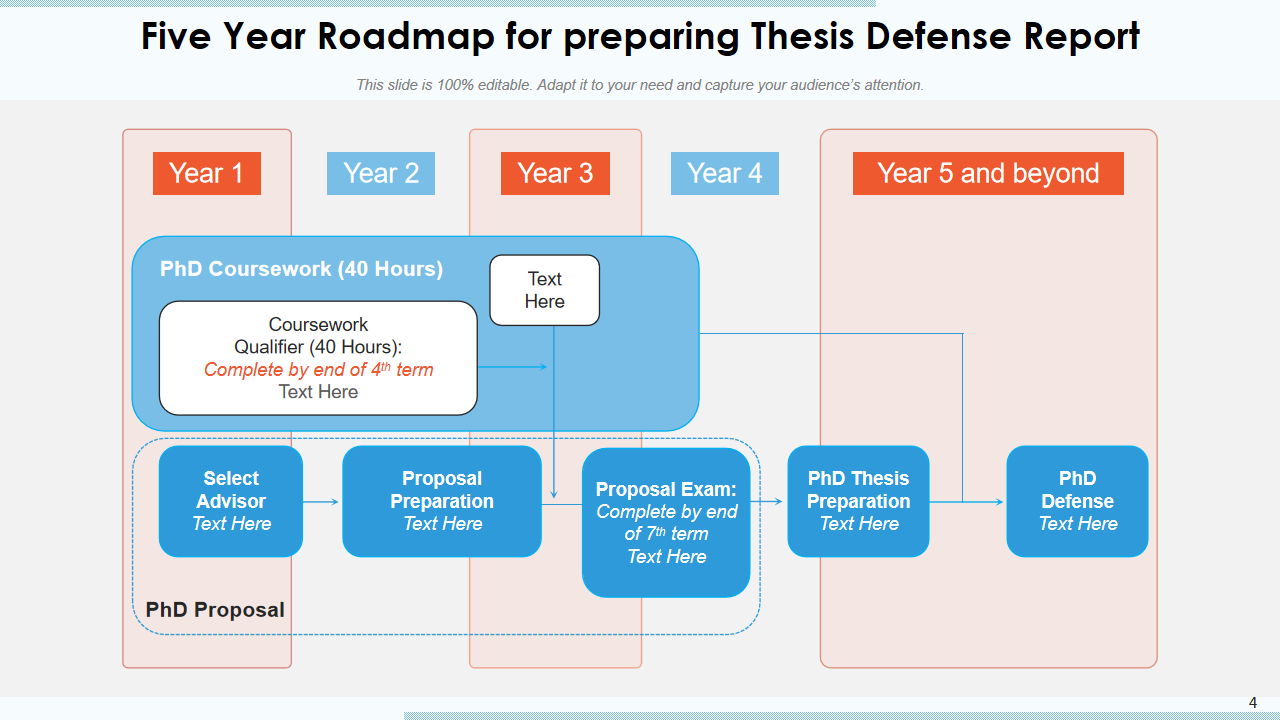
Template 8: Key Preparation Tips for Thesis Defense
Inside you'll discover a treasure trove of helpful tips, including how to dress for success, handle anxiety, delegate effectively, think ahead, and prepare answers to probable inquiries. To ensure a professional, composed, and confident presentation that makes an indelible impression, this slide is not only for students; it is a compass for everyone ready to convey their thoughts convincingly.
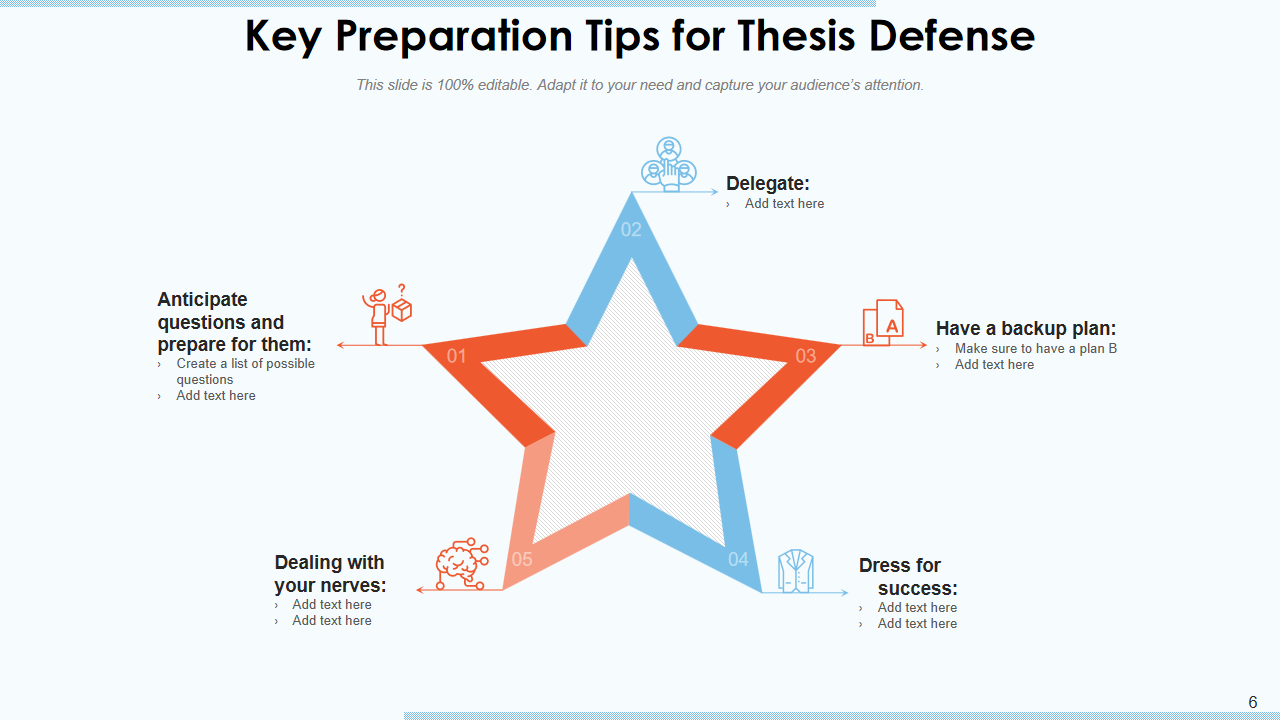
Template 9: Percentage of code-switching used by participants in Thesis Defense
This slide offers a graphical depiction of the Participant demographic's use of code-switching (the fluent mixing of languages) in their defense. This slide is useful for anyone studying language, culture, and education and for teachers looking to better their students' presenting abilities across languages. Get it from the link below.
Read our blogs on top one-pager templates available to prepare a thesis quickly and best.
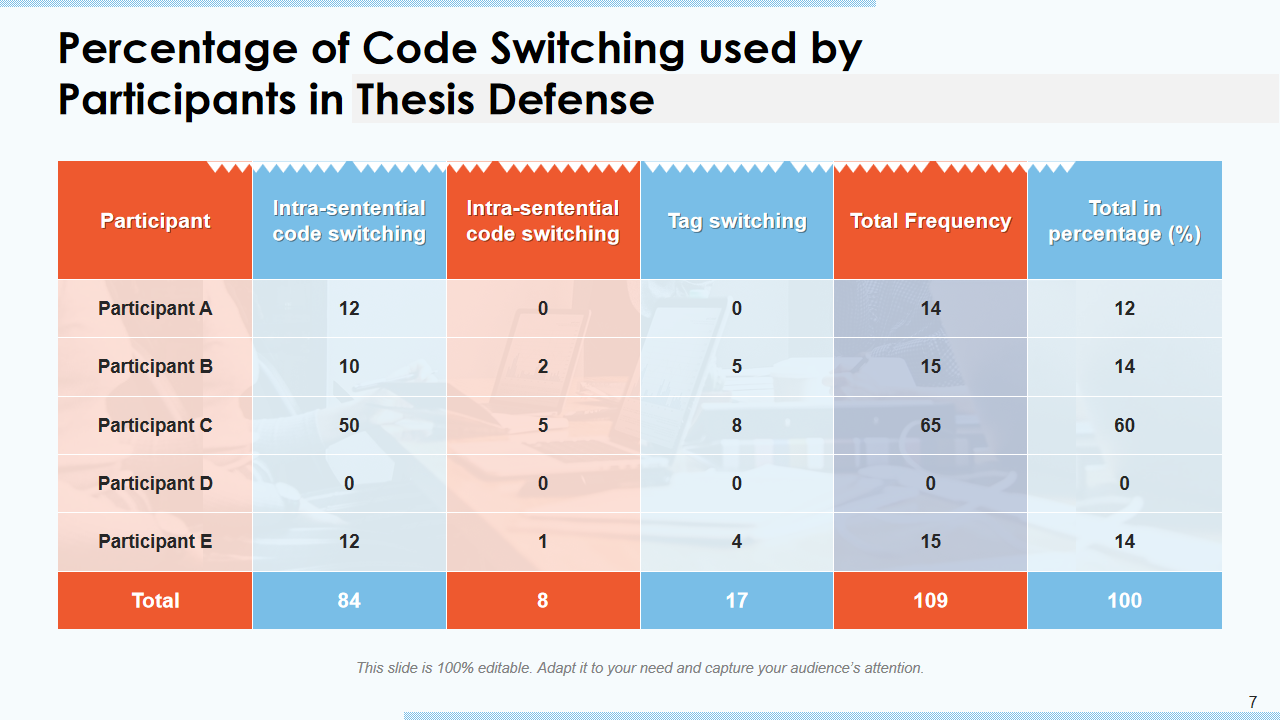
Template 10: Thesis Defense Invitation Form with Required Documents
This slide provides a one-stop shop for organizing your thesis defense invitations. Date, time, and location are all included for the benefit of the speakers and the reviewers. This slide is more than just an invitation; it serves as a literature review that details the thesis topic, required materials, the extent of the research, and even a preview of what's to come. This slide is ideal for universities, academics, and presenters since it guarantees a well-prepared and organized defense.

Prepare a Thrilling Thesis with Us!
Let SlideTeam be the maestro behind the scenes of your exciting thesis defense symphony. Our essential Thesis Defense Templates will ensure your presentation is symphony in style and design. Raise the bar on your defense and leave your assessors in wonder. Use SlideTeam's potency to your advantage and start directing your future now. This is the station where you may tune in to greatness; each slide is a work of art.
FAQs on Thesis Defense
What is usually asked in thesis defense.
You may find everything you need to organize invitations for your thesis defense on the "Invitation Form with Required Documents" slide. The speakers and reviewers will appreciate the inclusion of the date, time, and venue. This slide is more than an introduction; it's a road map that lays out the thesis's subject, resources needed, research scope, and even a sneak peek at what's coming. Academic institutions, public speakers, and presenters may all benefit from this slide since it ensures a well-prepared and coordinated defense.
How do you prepare for a thesis defense?
Using a preexisting thesis as a starting point has several advantages when preparing for your thesis defense. Using a template is a great way to ensure that the formatting and style of your documents are consistent from beginning to end. They allow you to devote more time to writing and less on formatting. Templates adhere to strict academic guidelines, making them appropriate for use in the classroom and lending an air of professionalism to any assignment. Charts and diagrams may be easily included to enhance reading and comprehension. Also, with a good template, adjusting things is a breeze. As a result of their ability to streamline the writing process, enhance the paper's aesthetic appeal, and contribute to a polished, cohesive final product, thesis templates are an essential tool for effective and successful thesis preparation.

How do you start a thesis defense?
The first part of a thesis defense lays the groundwork for a strong presentation. Start by saying hello and thanking them for the chance. Introduce your topic with an attention-grabbing title slide, then go on to a summary of your study aims. Provide background information and describe your research topic or hypothesis explicitly. Create an outline of your presentation, emphasizing the most critical points. Get people interested by discussing the importance and applicability of your findings. Create a connection with the reviewers via brief, intriguing introductions. To provide an effective and confident defense of your thesis, you need to start well.
Why Use Thesis Templates?
There are several benefits to using a thesis template. Using a template as a starting point, you may maintain uniformity in your document's formatting and style. They help you concentrate on content rather than design, which saves time. Academic standards are followed by templates, making them suitable for use at universities and adding a touch of professionalism to any project. Integrating visual aids like charts and diagrams is simple, which improves readability and understanding. In addition, modifications may be made quickly and easily using a template.
Related posts:
- How to Design the Perfect Service Launch Presentation [Custom Launch Deck Included]
- Quarterly Business Review Presentation: All the Essential Slides You Need in Your Deck
- [Updated 2023] How to Design The Perfect Product Launch Presentation [Best Templates Included]
- 99% of the Pitches Fail! Find Out What Makes Any Startup a Success
Liked this blog? Please recommend us

Must-have Product Page Templates with Examples and Samples

Must-have Product Handout Templates with Samples and Examples
This form is protected by reCAPTCHA - the Google Privacy Policy and Terms of Service apply.

Got any suggestions?
We want to hear from you! Send us a message and help improve Slidesgo
Top searches
Trending searches

61 templates

143 templates

48 templates

classical music
33 templates

39 templates

56 templates
Thesis Defense Presentation templates
If you are ready to defend your dissertation, our free thesis defense ppt templates and google slides themes are a great tool for you to impress the committee and get that desired degree you have always wanted..
- Calendar & Weather
- Infographics
- Marketing Plan
- Project Proposal
- Social Media
- Thesis Defense
- Black & White
- Craft & Notebook
- Floral & Plants
- Illustration
- Interactive & Animated
- Professional
- Middle School
- High School
- Career & Technical Education
- Emotional Intelligence
- Foreign Language
- High School Electives
- Language Arts
- Physical Education
- Practical Life
- Social Skills
- Social Studies
- Instagram Post
- Instagram Stories

It seems that you like this template!
Premium template.
Unlock this template and gain unlimited access

Register for free and start downloading now
Chemistry thesis.
Everything in this world is composed of atoms and, within science, chemistry is what studies these. Thanks to chemists we can understand what our universe is made of. As a graduate student who has chosen this career path, you’re about to finish your master’s program, but only the thesis defense...
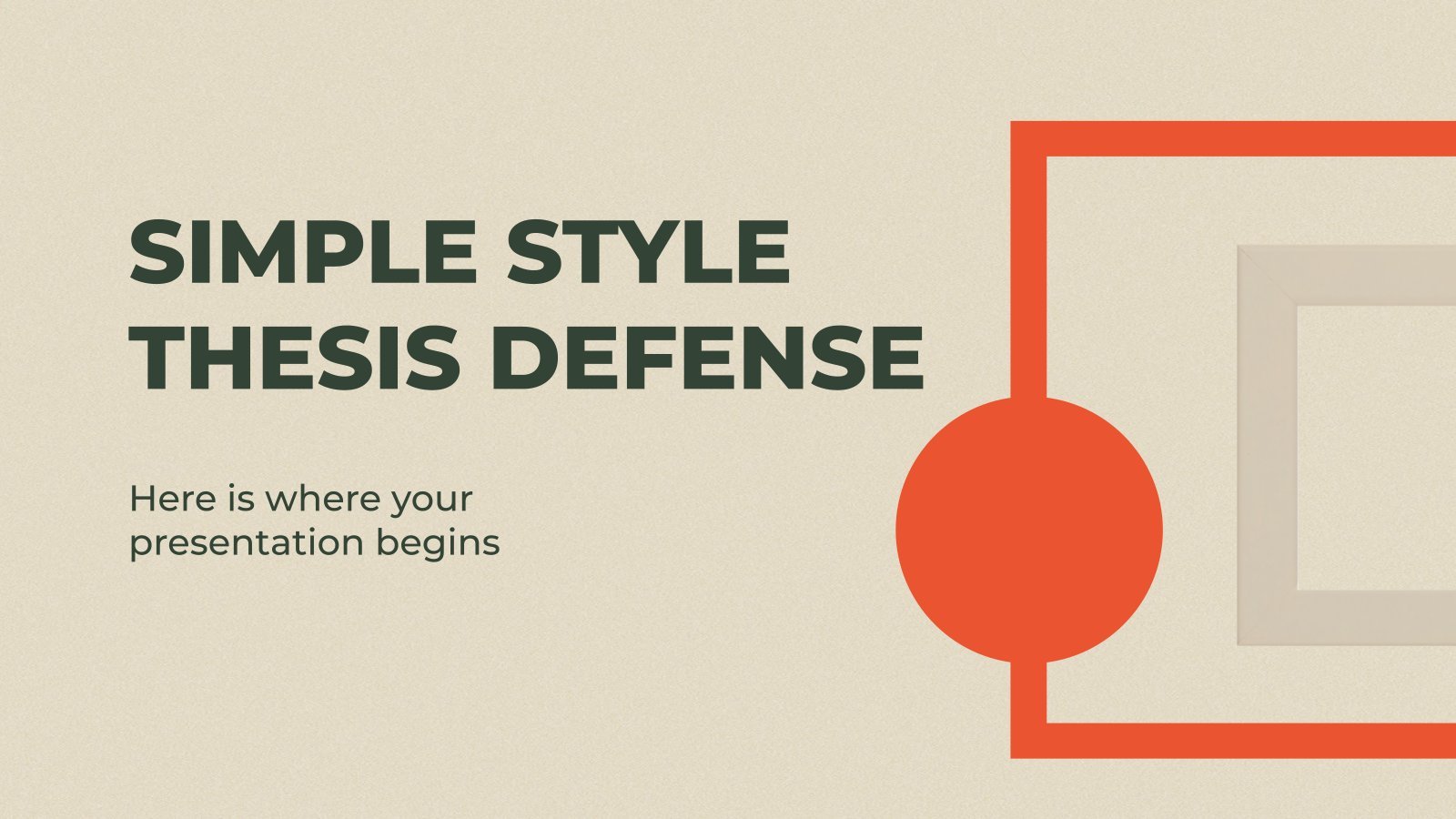
Simple Style Thesis Defense
We know how much work involves completing a thesis, and that is why it is also important that you get to impress the committee when making your final presentation. If you are looking for something simple but at the same time formal, take a look at this proposal from Slidesgo....

Egyptian History Thesis
Egyptian history is always a fascinating topic, full of mysteries and secrets. If your thesis is about this and you’re looking for a good way to present your findings clearly, why don’t you give this great template by Slidesgo a try?

Muslim Festivities and Celebrations Thesis
Download the Muslim Festivities and Celebrations Thesis presentation for PowerPoint or Google Slides. Congratulations, you have finally finished your research and made it to the end of your thesis! But now comes the big moment: the thesis defense. You want to make sure you showcase your research in the best...

Elegant Bachelor Thesis
Present your Bachelor Thesis in style with this elegant presentation template. It's simple, minimalist design makes it perfect for any kind of academic presentation. With an array of features such as section dividers, images, infographics and more, you can easily create a professional and creative presentation that stands out from...

Elegant Black & White Thesis Defense
Present your research findings with grace and assertiveness through this template. Available for Google Slides and PowerPoint, this design set offers minimalistic charm with its simple, gray scale elegance. The template not only provides a polished platform to showcase your thesis but also ensures seamless and efficient delivery of your...

Cellular Respiration and its Impact on Health Research Thesis Defense
Download the "Cellular Respiration and its Impact on Health Research Thesis Defense" presentation for PowerPoint or Google Slides. Congratulations, you have finally finished your research and made it to the end of your thesis! But now comes the big moment: the thesis defense. You want to make sure you showcase...

Create your presentation Create personalized presentation content
Writing tone, number of slides, dissertation defense - doctor of philosophy (ph.d.) in history.
Download the "Dissertation Defense - Doctor of Philosophy (Ph.D.) in History" presentation for PowerPoint or Google Slides. As university curricula increasingly incorporate digital tools and platforms, this template has been designed to integrate with presentation software, online learning management systems, or referencing software, enhancing the overall efficiency and effectiveness of...

Vintage French Literature Thesis
Download the Vintage French Literature Thesis presentation for PowerPoint or Google Slides. Congratulations, you have finally finished your research and made it to the end of your thesis! But now comes the big moment: the thesis defense. You want to make sure you showcase your research in the best way...

Social Issues Thesis: Violence Against Women
Download the "Social Issues Thesis: Violence Against Women" presentation for PowerPoint or Google Slides. Congratulations, you have finally finished your research and made it to the end of your thesis! But now comes the big moment: the thesis defense. You want to make sure you showcase your research in the...
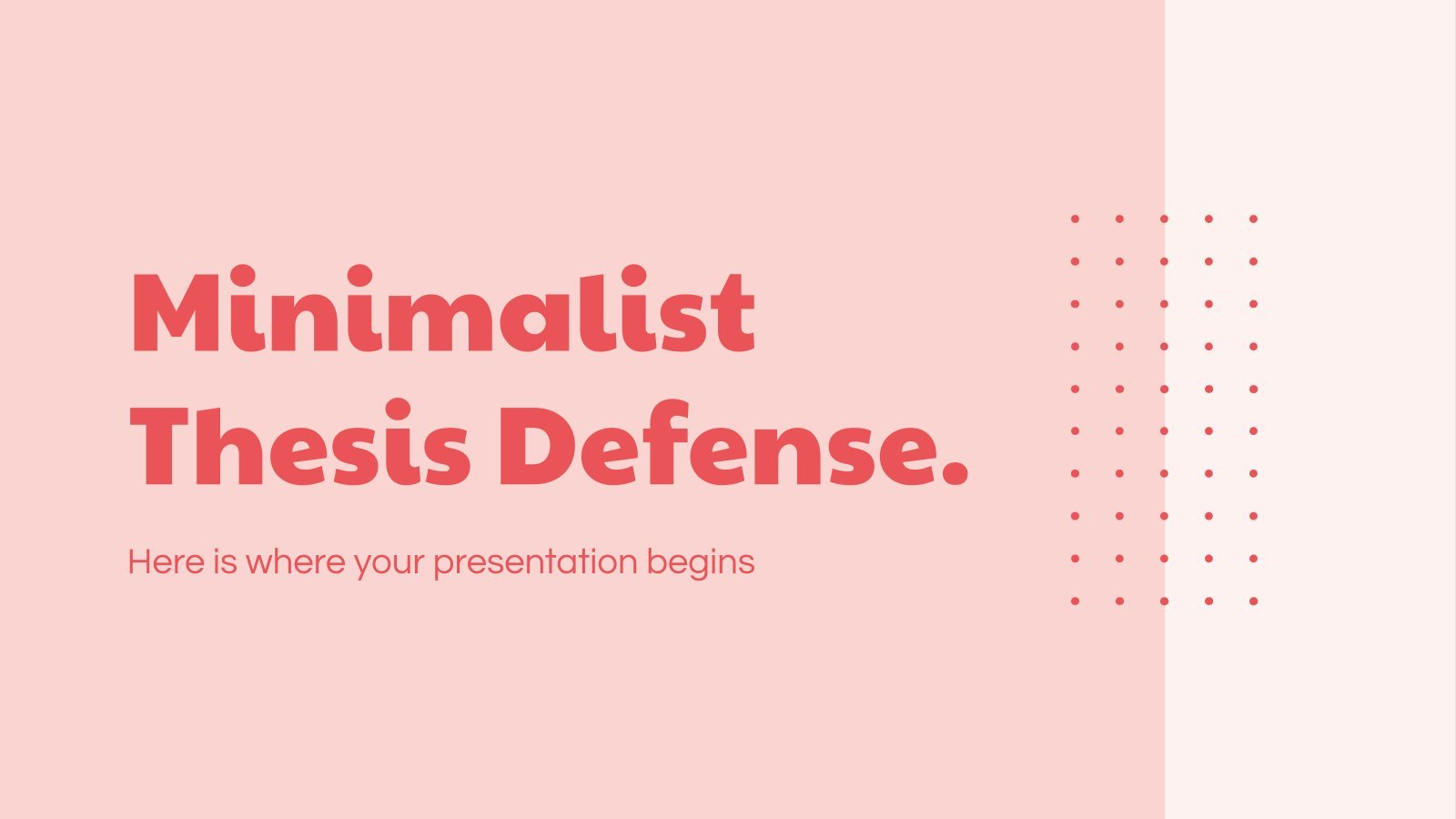
Minimalist Thesis Defense
Get rid of all that nervousness and enter the room full of confidence and willing to impress everyone in your thesis defense. Wait, first you must customize this new template so that your presentation is ready! Nothing feels as boring to the assessment committee than overcrowded slides, so our proposal...

After months or even years of researching about art and a lot of hard work, you’ve at last finished your master’s thesis. Now it’s time for the crucial part: the defense. Impress the committee and get that degree with the help of Slidesgo!

Thesis Proposal and Writing - Master of Arts in History
Download the "Thesis Proposal and Writing - Master of Arts in History" presentation for PowerPoint or Google Slides. As university curricula increasingly incorporate digital tools and platforms, this template has been designed to integrate with presentation software, online learning management systems, or referencing software, enhancing the overall efficiency and effectiveness...

Descartes' Method of Doubt Thesis Defense
Have you ever doubted everything, without exception? Well, that's exactly what René Descartes did with his famous method of doubt. He questioned all his beliefs and examined every single one of them, until he finally concluded that the only thing he could be sure of was his own existence. If...

Formal Research Paper Slideshow
Have you seen these slides? They are perfect for presenting your research paper! First of all, because we have included all the necessary sections of this type of work, such as hypothesis, objectives, methodology, analysis and the conclusions of the paper. The second reason is that the formal style will...

Final Year Project Thesis Defense
Download the "Final Year Project Thesis Defense" presentation for PowerPoint or Google Slides. Congratulations, you have finally finished your research and made it to the end of your thesis! But now comes the big moment: the thesis defense. You want to make sure you showcase your research in the best...

Scientific Research Thesis Defense
There are many theses in the world about almost all fields of study. Math? Physics? Chemistry? Biology? Humanities? But wait, how about a thesis about... scientific research? It's like a thesis on how to do a thesis! For the curious minds, we've got this editable template, filled with different sections...

Dissertation Proposal - Doctor of Philosophy (Ph.D.) in History
Download the "Dissertation Proposal - Doctor of Philosophy (Ph.D.) in History" presentation for PowerPoint or Google Slides. As university curricula increasingly incorporate digital tools and platforms, this template has been designed to integrate with presentation software, online learning management systems, or referencing software, enhancing the overall efficiency and effectiveness of...
- Page 1 of 60
Register for free and start editing online

IMAGES
VIDEO